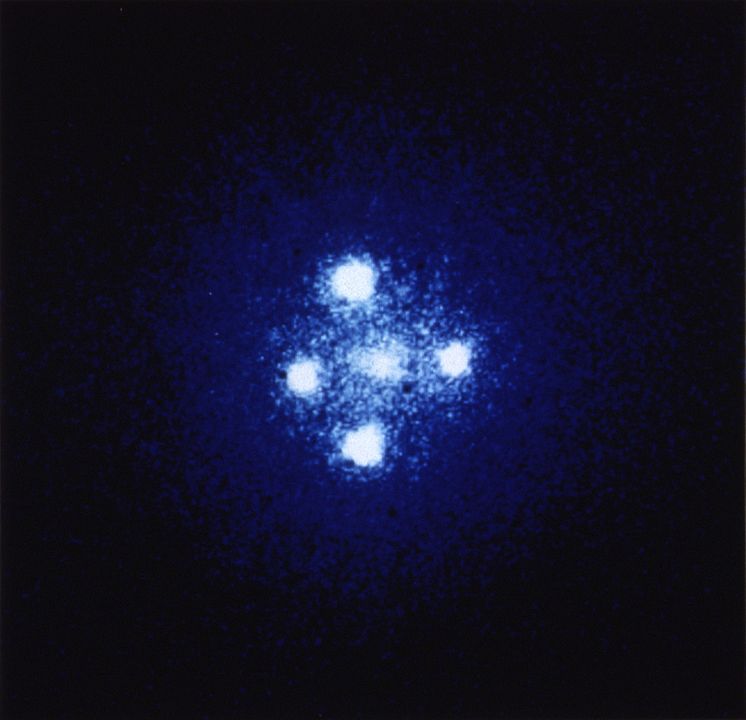Signatures of microlensing in gravitational waves

There is a variety of predictions from the general theory of relativity. And usually they are treated in the popular imagination somehow independently. This would be the case of gravitational waves and gravitational lenses, but in reality nothing prevent them to combine, even at a ‘micro’ level.
A gravitational lens is any object that deflects light by gravitation as described by the general theory of relativity; it is analogous to a lens in optics. The prediction of a gravitational lensing effect was confirmed repeatedly in observations on quasars. In 1979 an apparently double quasar was discovered, due to the multiple image of a single quasar caused by gravitational lensing by a galaxy, or cluster of galaxies, along the line of sight between the observer and the quasar.
Gravitational waves are the result of the prediction that an accelerating mass would lose energy in the form of radiated waves that propagate through a gravitational field. Gravitational-wave astronomy has recently become a reality with the first detection of gravitational waves (GW) by the Laser Interferometer Gravitational-Wave Observatory (LIGO) and Virgo ground-based interferometers. At least eleven events have been reported to date by the LIGO and Virgo detectors, and this number will quickly increase to tens of events in the coming years.
Some of these events may correspond to gravitationally lensed events with magnification factors ranging from a few tens to a few hundreds.
The most likely lenses for such events would be massive galaxies or galaxy clusters. But, on the other extreme of the lens mass regime, compact objects with masses of a few hundreds to a few tens solar masses can also act as lenses. In this case, the geometric optics limit is not valid since the Schwarszchild radius of the lens is comparable to the wavelength of the wave. For these relatively low masses, the lensing eff ect has a modest impact on the average magnification, but it can introduce a frequency dependence on the magnification.
These microlenses are often considered as isolated point sources, something only valid for sources within our galaxy, when, typically, they are always embedded in the potential of the macrolens (galaxy or cluster) they belong to. The e ffect of the macromodel can not be ignored as it can have a significant impact on the observed lensing signal.
If the time delay between two lensed waves is of the order of the inverse of the frequency of the GW, both waves interfere and the observed signal could show this interference. Now, a team of researchers explores 1 the regime of GWs magnified by a macromodel in the presence of microlenses with stellar masses. They show how, under certain circumstances and for realistic scenarios, a population of microlenses (for instance stars and remnants from a galaxy halo or from the intracluster medium) embedded in a macromodel potential (galaxy or cluster) can conspire together to produce time delays of the order of one millisecond, which would produce significant interference distortions in the observed strains. This is the first study that explores the e ffect of a realistic population of microlenses, including a macromodel, on strongly lensed gravitational waves.
At sufficiently large magnification factors (of several hundred), microlensing e ffects should be common in gravitationally lensed gravitational waves. The researchers explored the regime where the predicted signal falls in the frequency range probed by LIGO/Virgo and found that stellar mass microlenses, permeating the lens plane, and near critical curves, can introduce interference distortions in strongly lensed gravitational waves. Lensed events with negative parity, or saddle points (which have never before been studied in the context of gravitational waves), and that take place near caustics of macromodels, are more likely to produce measurable interference e ffects at LIGO/Virgo frequencies.
An interesting application of lensing of GWs is using the time delay in the context of multimessenger astrophysics. These time delays induced by gravitational lensing of gravitational waves in unison with their electromagnetic counterpart could be used to constrain the cosmological models (for instance by setting bounds on the total neutrino mass).
Author: César Tomé López is a science writer and the editor of Mapping Ignorance
Disclaimer: Parts of this article may have been copied verbatim or almost verbatim from the referenced research paper.
References
- J. M. Diego, O. A. Hannuksela, P. L. Kelly, G. Pagano4, T. Broadhurst, K. Kim, T. G. F. Li and G. F. Smoot (2019) Observational signatures of microlensing in gravitational waves at LIGO/Virgo frequencies A&A 627, A130 doi: 10.1051/0004-6361/201935490 ↩